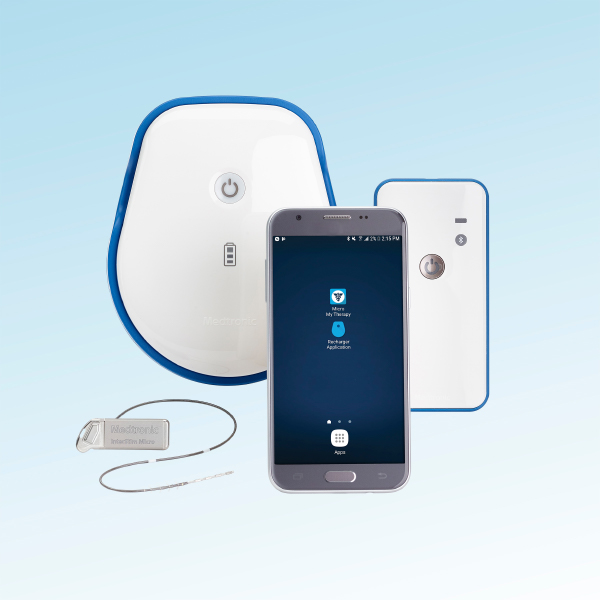 The InterStim Micro system comes with (from left) a neurostimulator, recharger, mobile phone smart programmer app and communicator (not pictured: recharging dock and recharger belt). Photo Credit: Medtronic
The InterStim Micro system comes with (from left) a neurostimulator, recharger, mobile phone smart programmer app and communicator (not pictured: recharging dock and recharger belt). Photo Credit: Medtronic
When patients experience debilitating overactive bladder and bowel symptoms, they are often reluctant to raise the issue with their physician. Either they are unaware of treatment options or fear the stigma, but their untreated symptoms will not change and can worsen.
Medications, physical therapy and other options may fail in the treatment of urinary frequency, urgency, retention with or without incontinence, as well as fecal incontinence. Women can turn to an MRI-safe, rechargeable device -- the InterStimTM Micro System -- now available at NKCH.
Stigma
“These issues have a huge effect on women,” said Ian M. Rosbrugh, MD, FACOG, the only full-time Northland gynecologist board certified in female pelvic medicine and reconstructive surgery. “Incontinence often causes patients to go through multiple pads or briefs and makes it difficult to sleep due to the frequent need to urinate.” Dr. Rosbrugh operates a urogynecology practice at the Pelvic Health and Reconstructive Surgery Clinic at Meritas Health Pavilion for Women.
“If a patient brings this up, it is probably bothering them and quite severe,” Dr. Rosbrugh said. “I would ask physicians to further inquire about how much it is impacting the patient’s life and how they might want to pursue treatment.”
Treatment
Sacral neuromodulation treatment is a two-stage procedure. First, the patient undergoes a trial period of four to five days with temporary leads delivering stimulation at the sacral nerve to thwart symptoms. The minimally invasive procedure lasts about 30 minutes. If symptoms improve after one week, Dr. Rosbrugh implants an InterStim, with the aid of fluoroscopy, which delivers mild electrical impulses to the sacral nerve. The outpatient procedure is performed in about an hour. He noted that in addition to risks related to surgery, complications can include pain at the implant sites, infection, lead migration and device problems.
“Patients can opt for the new rechargeable or the standard nonrechargeable device,”
Dr. Rosbrugh said. “Some may prefer the smaller rechargeable, MRI-safe version, while others may not be keen on remembering to charge the battery, although they will need to replace it more often.”
The rechargeable InterStim Micro is 2.8 cm and has a 15-year battery lifespan. The InterStim II is 12.5 cm and has a nonrechargeable battery that lasts five to six years. To recharge the device, patients simply remove the recharger from a charging dock and place it in a recharging belt they wear for 20 minutes once a week. Both the rechargeable and nonrechargeable versions come with a smart programmer and communicator for adjusting the device.

Ian M. Rosbrugh, MD, FACOG
Dr. Rosbrugh earned his medical degree from Loma Linda University Medical Center and completed his residency in obstetrics and gynecology at the University of Kansas Medical Center. He is double board certified in obstetrics and gynecology and female pelvic medicine and reconstructive surgery.